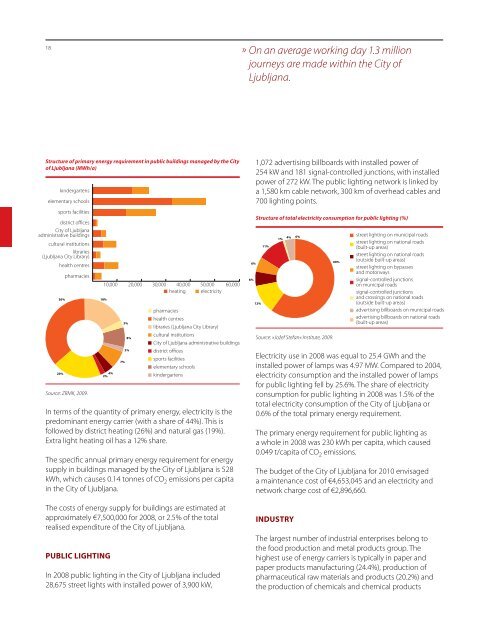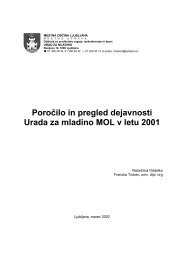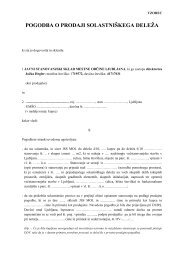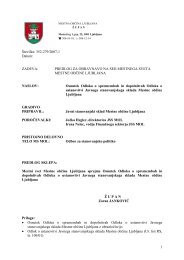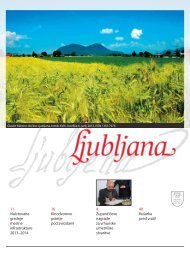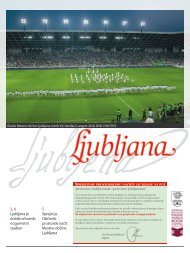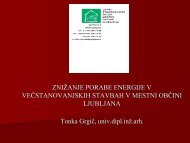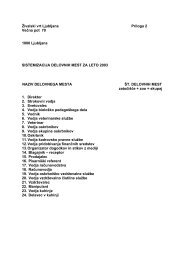Energy for the City of the Future - Ljubljana
Energy for the City of the Future - Ljubljana
Energy for the City of the Future - Ljubljana
Create successful ePaper yourself
Turn your PDF publications into a flip-book with our unique Google optimized e-Paper software.
18<br />
» On an average working day 1.3 million<br />
journeys are made within <strong>the</strong> <strong>City</strong> <strong>of</strong><br />
<strong>Ljubljana</strong>.<br />
Structure <strong>of</strong> primary energy requirement in public buildings managed by <strong>the</strong> <strong>City</strong><br />
<strong>of</strong> <strong>Ljubljana</strong> (MWh/a)<br />
kindergartens<br />
elementary schools<br />
sports facilities<br />
district <strong>of</strong>fices<br />
<strong>City</strong> <strong>of</strong> <strong>Ljubljana</strong><br />
administrative buildings<br />
cultural institutions<br />
libraries<br />
(<strong>Ljubljana</strong> <strong>City</strong> Library)<br />
health centres<br />
36% 18%<br />
20%<br />
pharmacies<br />
Source: ZRMK, 2009.<br />
4%<br />
2%<br />
In terms <strong>of</strong> <strong>the</strong> quantity <strong>of</strong> primary energy, electricity is <strong>the</strong><br />
predominant energy carrier (with a share <strong>of</strong> 44%). This is<br />
followed by district heating (26%) and natural gas (19%).<br />
Extra light heating oil has a 12% share.<br />
The specific annual primary energy requirement <strong>for</strong> energy<br />
supply in buildings managed by <strong>the</strong> <strong>City</strong> <strong>of</strong> <strong>Ljubljana</strong> is 528<br />
kWh, which causes 0.14 tonnes <strong>of</strong> CO 2 emissions per capita<br />
in <strong>the</strong> <strong>City</strong> <strong>of</strong> <strong>Ljubljana</strong>.<br />
The costs <strong>of</strong> energy supply <strong>for</strong> buildings are estimated at<br />
approximately €7,500,000 <strong>for</strong> 2008, or 2.5% <strong>of</strong> <strong>the</strong> total<br />
realised expenditure <strong>of</strong> <strong>the</strong> <strong>City</strong> <strong>of</strong> <strong>Ljubljana</strong>.<br />
Public lighting<br />
10,000 20,000 30,000 40,000 50,000 60,000<br />
heating electricity<br />
7%<br />
3%<br />
8%<br />
2%<br />
pharmacies<br />
health centres<br />
libraries (<strong>Ljubljana</strong> <strong>City</strong> Library)<br />
cultural institutions<br />
<strong>City</strong> <strong>of</strong> <strong>Ljubljana</strong> administrative buildings<br />
district <strong>of</strong>fices<br />
sports facilities<br />
elementary schools<br />
kindergartens<br />
In 2008 public lighting in <strong>the</strong> <strong>City</strong> <strong>of</strong> <strong>Ljubljana</strong> included<br />
28,675 street lights with installed power <strong>of</strong> 3,900 kW,<br />
6%<br />
6%<br />
1,072 advertising billboards with installed power <strong>of</strong><br />
254 kW and 181 signal-controlled junctions, with installed<br />
power <strong>of</strong> 272 kW. The public lighting network is linked by<br />
a 1,580 km cable network, 300 km <strong>of</strong> overhead cables and<br />
700 lighting points.<br />
Structure <strong>of</strong> total electricity consumption <strong>for</strong> public lighting (%)<br />
12%<br />
11%<br />
1%<br />
4% 0%<br />
Source: »Jožef Stefan« Institute, 2009.<br />
Electricity use in 2008 was equal to 25.4 GWh and <strong>the</strong><br />
installed power <strong>of</strong> lamps was 4.97 MW. Compared to 2004,<br />
electricity consumption and <strong>the</strong> installed power <strong>of</strong> lamps<br />
<strong>for</strong> public lighting fell by 25.6%. The share <strong>of</strong> electricity<br />
consumption <strong>for</strong> public lighting in 2008 was 1.5% <strong>of</strong> <strong>the</strong><br />
total electricity consumption <strong>of</strong> <strong>the</strong> <strong>City</strong> <strong>of</strong> <strong>Ljubljana</strong> or<br />
0.6% <strong>of</strong> <strong>the</strong> total primary energy requirement.<br />
The primary energy requirement <strong>for</strong> public lighting as<br />
a whole in 2008 was 230 kWh per capita, which caused<br />
0.049 t/capita <strong>of</strong> CO 2 emissions.<br />
The budget <strong>of</strong> <strong>the</strong> <strong>City</strong> <strong>of</strong> <strong>Ljubljana</strong> <strong>for</strong> 2010 envisaged<br />
a maintenance cost <strong>of</strong> €4,653,045 and an electricity and<br />
network charge cost <strong>of</strong> €2,896,660.<br />
IndustrY<br />
60%<br />
street lighting on municipal roads<br />
street lighting on national roads<br />
(built-up areas)<br />
street lighting on national roads<br />
(outside built-up areas)<br />
street lighting on bypasses<br />
and motorways<br />
signal-controlled junctions<br />
on municipal roads<br />
signal-controlled junctions<br />
and crossings on national roads<br />
(outside built-up areas)<br />
advertising billboards on municipal roads<br />
advertising billboards on national roads<br />
(built-up areas)<br />
The largest number <strong>of</strong> industrial enterprises belong to<br />
<strong>the</strong> food production and metal products group. The<br />
highest use <strong>of</strong> energy carriers is typically in paper and<br />
paper products manufacturing (24.4%), production <strong>of</strong><br />
pharmaceutical raw materials and products (20.2%) and<br />
<strong>the</strong> production <strong>of</strong> chemicals and chemical products


